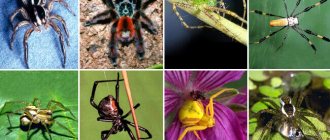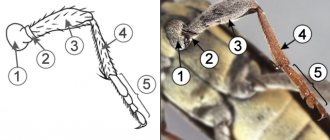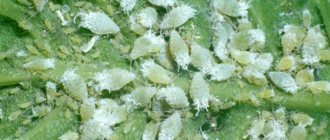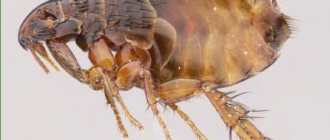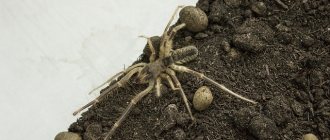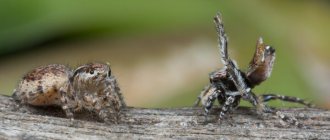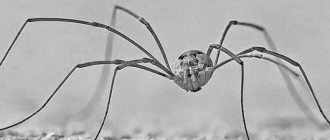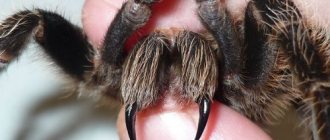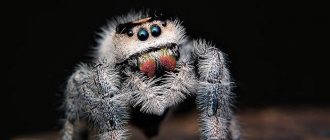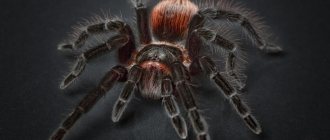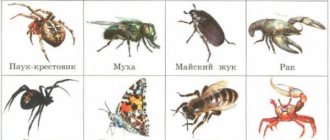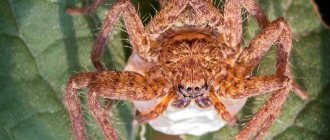Spiders (Araneae) are an order of arthropods, the first in the number of known species in the class of arachnids. Representatives of the order are distributed everywhere. Spiders are carnivores, feeding primarily on insects or other small animals. The lifestyle is varied. Dioecious. Spiders destroy insect pests in significant quantities, which determines their beneficial value.
Argiope (Argiope sp.)
Structure
The body consists of two sections: the cephalothorax, covered on top with a continuous armored shield (consisting of a durable material - chitin) and a mostly undivided abdomen, connected to each other by a thin stalk. The cephalothorax is divided by a groove into two regions: the head and the chest; of these, the first bears two pairs of limbs: chelicerae and pedipalps, consisting of 6 segments. Chelicerae end in fangs. In sexually mature males, the tarsus of the pedipalp is transformed into a copulatory apparatus (cymbium). Between the chelicerae at the top of the tubercle there is an oral opening used for sucking. The abdomen of most spiders is covered with a soft chitinous cover. Spiders lack antennae characteristic of insects. The body and paws are covered with hairs or scales.
Behind the pedipalps, four pairs of legs are attached to the cephalothorax, each of which consists of 7 segments. On the front convex frontal part of the cephalothorax there are eyes, numbering 8, 6, rarely 2, usually located in two rows. The eyes are simple, of two kinds: the middle pair of front eyes is equipped with a special retina and an accommodative apparatus, the remaining eyes are called accessory and have an internal reflective layer. The front eyes are also the only ones that have eye muscles that allow them to move the retina.
Article on the topic Myths and legends about spiders
The abdomen is generally oval in shape, less often round and angular; below, near its base, there is a genital opening, in males in the form of a simple transverse slit, in females it is surrounded by a thickened chitinous plate (epigina) with a tongue-shaped, curved process. The limbs of two abdominal segments are transformed into arachnoid warts. All spiders have four pairs of walking legs.
The circulatory system is open. The spider's heart is a tube located in the upper part of the body, with 3-4 several ostia. The terminal branches of the arteries pour hemolymph into the spaces between the internal organs, from where it enters the pericardial portion of the body cavity, and then through the ostia into the heart. The hemolymph of arachnids contains a respiratory pigment - hemocyanin.
Wolf spider (Lycosidae)
The respiratory system of spiders is quite unique. They have lung sacs that look like the pages of a book because they have plates. They open with breathing holes covered with lids. There are also ordinary tracheas, which look like long tubes and transport oxygen through the respiratory openings (spiracles) to the tissues of the organs.
Excretory system. Most spiders convert nitrogenous waste into uric acid, which can be excreted as a dry substance. The Malpighian vessels extract waste from the blood into the hemocoel and remove it through the anus. However, some primitive spiders, Mesothelae and Mygalomorphae, use large amounts of water to excrete nitrogenous waste in the form of ammonia.
Sense organs. Spiders have several sensory organs to sense the environment in which they live. Spiders don't have ears. The spider hears using tiny thrichobotria hairs located on its legs. With their help, the spider is able to very accurately determine the origin of a sound by interpreting the movement of air produced by this sound. The joints of spiders' limbs have slit sensilla that sense force and vibration. Like most arthropods, spiders lack balance and acceleration sensors and rely on their eyes to determine which way to move.
The visual acuity of some jumping spiders is ten times greater than that of dragonflies, which have the best vision among insects. There are spiders with a reduced number of eyes. Of these, the most numerous are individuals with six eyes (for example, Periegops suterii); other species have four eyes, and some have only two. Cave species have no eyes or possess vestigial eyes that are unable to see.
Spiders sense odors using special sensitive hairs located on their legs. The spider has no taste sensations in its mouth. The spider senses whether its prey is edible using chemically sensitive hairs located on its legs.
Central nervous system. The cephalothorax contains two nerve ganglia, which form many brain nerves, and they diverge from the brain to the legs, eyes and other organs of the spider. The brain can occupy from 20% to 30% of the volume of the cephalothorax. Despite having a relatively small central nervous system, some spiders exhibit complex behavior, including the ability to use trial and error.
Types of spiders
| Number of families | Species | |
| Belgium | 38 | 701 |
| Netherlands | 40 | 621 |
| Germany | 38 | 1004 |
| Switzerland | 41 | 945 |
| Austria | 40 | 984 |
| Czech | 38 | 841 |
| Sweden | 38 | 906 |
| Poland | 37 | 792 |
| Central Europe | 43 | 1313 |
| Russia + former USSR countries | 2888 | |
| Total | 112 | 43.678 |
The order of spiders includes 2 suborders: Arthoplastae (97 species) and Opisthothelae. The latter is divided into Araneomorphs (43,834) and Mygalomorphs (2,875). The arthroplasties have changed less during evolution. They have retained clear segmentation and are more similar to other arthropods.
Safe
All spiders have venom. But those whose poison is minimally concentrated are harmless. Due to their size, small individuals cannot produce enough poison to cause a reaction in the human body.
Haymaker
Small spider (2-10 mm). Leg size 40-50 mm. Available on all continents. Has 8 eyes (2 central, 6 lateral). It differs in the way the eggs are packaged. Instead of sealing, it weaves bags like string bags for storage. Places cobwebs in dark, damp places. In people's homes, on the contrary, they like warm, dry places (on windowsills).
House spider
From 6 to 12 mm. Brown with leopard print. Extremely common. But rare in the wild. Prefers to live next to a person. It can easily be confused with the poisonous hobo spider. Can't weave a sticky web. Its networks are loose. Because of this, the victim is easily confused.
South Russian tarantula
Harmless, despite its threatening appearance. Body 2.5-3 cm. Deserts, steppes, forest deserts - these are the zones of its habitat. Lives and hunts in burrows. A female can give birth to up to 50 cubs. At first they live with their mother. The bitten area swells, may turn yellow, and hurt. But a bite is no more dangerous than a hornet attack.
Horse
This family has 5,000 species. Representatives copy the appearance of other animals. For example, ants, false scorpions. Leads a daily lifestyle. It has a viewing angle of almost 360 degrees, as well as claws on its limbs. The jumping spider is a harmless arthropod. It is not capable of biting through human skin.
Argiope Brünnich garden
A spider from the orb weaver family. It hurts. After 2-3 hours, the wound turns red and swells. The bite site becomes numb. The unpleasant feeling usually goes away after 2-3 days. Dangerous for those who are allergic to insect bites. Spiders are helpers; they destroy many pests. The body length of females is 2-2.5 cm, males 5 mm. The color of the body and legs is black and yellow. The spider Agriopa Brünnich is also called the “wasp spider” because of its bright striped color.
Poisonous spiders
In this article, we will call poisonous spiders those whose venom causes discomfort to humans, but is not fatal to him.
Tarantula
The tarantula family includes 143 species. Their bites are not dangerous to adults. But they cause very unpleasant symptoms: fever, cramps, chills, pain. There are fatalities involving cats. Therefore, if a child is bitten by a tarantula, you should immediately consult a doctor.
Cross
Its venom contains a neurotoxin. Causes headaches, joint pain, and weakness. A burning sensation and tissue necrosis appear at the site of the bite. In total, there are 600 species of cross spiders, about 30 are found on the territory of Russia. The spider “Krestovik” owes its name to the spots on its back that form a cross. This color element helps scare away animals.
Tramp
Brown in color, there are yellow spots on the belly. The hobo spider is a close relative of the house spider. It is distinguished by its aggressiveness and the consequences of its bite; its venom causes tissue death. Most common in Europe and America. Size 7-16 cm. Paws are short with a small span.
Deadly poisonous spiders
Females are more aggressive. The poison can be neurotoxic (affects the central nervous system) and necrotic (provokes tissue death).
Karakurt
Spider from the Black Widow genus. The poison is neurotoxic and oily. Only females bite. The fangs penetrate no deeper than 0.5 mm. The pain appears instantly. At the site of the bite, 2 red, inflamed dots form. After 10-15 minutes the poison begins to act actively. Convulsions occur in large muscles, then in the abdominal muscles, severe pain, tachycardia. Further delirium, confusion. Heart failure, respiratory arrest, and death occur.
The paws are shiny (as if varnished) in the shape of a comb. The body is covered with 13 red spots. Sometimes they are inscribed in a white frame. Adult spiders sometimes turn completely black.
Brown recluse spider
On the top of the body there is a pattern resembling a violin. The bite is accompanied by a slight burning sensation. After 3-8 hours, a blister with liquid appears at the site of the bite. It bursts. A hole is formed. This ulcer begins to expand. The temperature rises and nausea appears. There have been deaths from brown recluse spider bites. The poison causes necrosis and has a hemolytic (destroying red blood cells) effect. Found in the USA. Three pairs of eyes. Weaves webs in unpredictable places: clothes, boxes, baseboards.
Range and habitats
Spiders live all over the globe (except Antarctica), but warmer climates are home to the largest number of species. Spiders have established themselves in almost all habitats, with the exception of aerial and sea colonization. The exception is the silverback spider, which lives in water. A number of spider species hunt on the surface of the water. Spiders are found literally everywhere. Some spiders build nests, shelters and burrows, while others do not have a permanent habitat. For the most part, spiders are nocturnal animals.
What attracts cockroaches
Research shows that cockroaches are attracted to each other. They sense pheromones released by nearby insects thanks to special sensitive zones on their antennae. In total, the cockroach mustache has more than a hundred segments throughout its entire length, each of which is responsible for receiving relevant information from the outside world.
There are many factors that attract many different types of cockroaches. Wild or tree cockroaches may be uncontrollably attracted to bright lights at night. After this, they often remain in the living space forever.
Nutrition
All spiders are obligate predators that feed on a variety of animal foods (mainly insects). The only herbivorous species whose diet consists of 90% Belt bodies (special secretions from acacia leaves) is Kipling's bagheera (Bagheera kplingi). The young of some spiders from the families Anyphaenidae, Corinnidae, Clubionidae, Thomisidae and Salticidae feed on plant nectar. In captivity, some species of spiders are also known to feed on bananas, marmalade, milk, egg yolks and sausages.
In terrestrial ecosystems, these are one of the most important regulators of the number of insects, which they annually consume as food in a total of 400 to 800 million tons. Spiders hunt from ambush, catch victims using webs, or actively search for them. The victims are mainly arthropods: insects, centipedes, wood lice and other arachnids. Occasionally, spiders eat small vertebrates. Cases of spiders eating bats are often described. Having caught its prey, the spider kills it with poison and injects digestive juices into it. After some time (usually several hours), the spider sucks out the resulting nutrient solution.
Cross spider (Araneus sp.)
Lifestyle
The lifestyle of spiders is varied. They are divided into wandering ones, which catch prey on the ground or on plants, lying in wait and rushing at it, and sessile, or tenet ones, stretching webs in which the prey itself gets entangled. The trapping net is either spread on the ground at the entrance to the spider's burrow, or stretched on trees and bushes between the branches. The spider entwines the insect caught in the net with a web, after which it begins to suck it out. Spiders that make a burrow line its walls with cobwebs, and with the help of cobwebs they construct a hinged lid that closes the entrance to the burrow. Some tree spiders build living tubes or nests from webs, and sometimes use web threads only to fasten leaves rolled into a tube, forming the wall of the shelter.
Water spider - Argyroneta aquatica builds a web bell under water, attaches it to the underwater parts of plants and fills it with air. The body of a diving spider is covered with a layer of air, which is held by its short hairs that are not wetted by water.
A minority of species are social, forming "comunes" of anywhere from a few to 50,000 individuals. Although most spiders live no more than two years, tarantulas and other mygalomorphic spiders can live up to 25 years in captivity. Spiders are ectotherms, so the temperature of the environment affects their activity.
Web
The web consists of more than 50% fibroin protein. In all the main life manifestations that support the existence of the species - obtaining food, reproduction, settlement and surviving unfavorable conditions - spiders use webs. It is used to make a shelter and a catching device, with its help a complex mating procedure takes place, an egg cocoon and a wintering sac are woven from it, the young are carried by the wind on it, etc. The spider interacts with the outside world not so much directly, like other animals, but through their web adaptations, which for each species correspond to its vital needs.
The arachnoid apparatus was formed in spiders on the underside of the abdomen. The function of removing gland secretions to the outside was taken over by the abdominal limbs, which turned into arachnoid warts and retained mobility, which is very important when using a web. Spiders have several types of glands for different purposes.
Funnel-web or grass spider (Entelegynae)
Spider web is an elastic material that breaks only when stretched 200-400%. Spiders often reuse web silk by eating trapping threads damaged by rain, wind or insects. It is digested with the help of special enzymes.
Protection
There is good evidence that spiders' coloration is camouflage to help them avoid their main predators - birds and parasitic wasps, which have good color vision. Many species of spiders are colored to blend into their most common background, and some have distinctive coloring (stripes and spots, etc.). Some species, such as the smiling spider (Theridion grallator), have multiple color schemes, making it difficult for predators to recognize the species. Some species of spiders with strong venom, large jaws, or irritating hairs have spots of warning colors, and some actively display these colors when they are threatened. Many spiders in the family Theraphosidae have stinging hairs on their abdomens and use their legs to flick them off at attackers. These setae are fine meshes (setae) with fragile bases and a row of spines at the tip. The thorns cause severe irritation. The golden rolling spider (Carparachne aureoflava), native to the Namib Desert, escapes from parasitic wasps by rolling over on its side and rolling across sand dunes.
Article on the topic Arachnids: structure, physiology and development
Harm from cockroaches
Cockroaches spoil and contaminate food. We should not forget that cockroaches are potential carriers of typhoid bacilli, tuberculosis bacilli, other pathogenic bacteria and worm eggs. In addition, their unpleasant odorous secretions from special glands cause allergic diseases in some people, such as runny nose, eczema and hives.
New agents usually act effectively on cockroaches at first, but later they become “accustomed” to them. In fact, it is not the same insect that becomes accustomed to the poison, but its descendants, through selection for resistance, acquire insensitivity to the insecticide.
Reproduction
Spiders are dioecious; There is sexual dimorphism, expressed not only in the structure of the pedipalps, but also in size - males are usually smaller than females. Small and weak males are often eaten by the female after mating if they do not have time to escape. Apparently, the females of many spiders during copulation fall into a kind of cataleptic state, which makes it easier for the male to perform sexual function. The process of copulation of spiders itself is peculiar. In males, the last segment of the pedipalp is equipped with an appendage with a complex structure. The latter is the copulatory organ. It contains a cavity communicating with the external environment. Before copulation, the male collects the seminal fluid released from the genital opening into the epididymis, and then transfers the sperm to the female’s seminal receptacle. In some species, males mate with females that have just moulted and are too weak to be dangerous to the males. Females lay up to 3,000 eggs in one or more cocoons, which are maintained at constant humidity. In some species, the females then die.
Development
The nymphs go through all of their larval stages inside the egg and hatch as spiderlings, very small and sexually mature, but similar in shape to the adults. Some spiders care for their young, such as the wolf spider's brood clinging to the rough bristles on the mother's back, and the females of some species respond to the "begging" behavior of their young by giving them their prey if it no longer struggles, or even regurgitating food. Most spiders live only one to two years, although some tarantulas can live for more than 20 years in captivity.
Behavior in nature
The lifespan of a spider of this species is short. On average, according to statistics, an adult lives up to 1 year. In rare cases, up to 2 years. The natural habitat constantly exposes the crosses to danger. They have many enemies in nature, from birds to parasitic flies. Which are capable of laying their eggs directly in the body of the cross. Spiders do not tolerate bright sun, so they can mainly be found in shady places.
Surprisingly, few people know that such small arthropods as spiderworts are capable of traveling long distances. Thanks to their web, they roam from one structure to another. And if they have a favorable wind, they can glide across their networks for distances of up to 400 km.
An interesting fact is that inside its web, the spider does not stick to it. This is explained by the fact that it moves exclusively along dry threads, and not along sticky ones. In addition, it has been proven that web weaving in spiders is developed at the genetic level. This is explained by the fact that a young spider can weave its masterpiece no worse than an experienced adult spider.
Shedding
Like other arthropods, spiders must molt in order to grow because their cuticle (“skin”) cannot stretch. Therefore, in order to grow, they need to periodically shed their old chitinous shell, which is replaced by a new, larger one. Depending on the species, spiders can molt 5 to 10 times in their lifetime. With age, the frequency of molting decreases. Before molting, spiders move away from their shelters and refuse food. The legs and abdomen become darker. A new exoskeleton is formed under the old one.
Economic importance
Spiders destroy insect pests in significant quantities, which determines their beneficial value. Some species of spiders are indicators of the health of the ecosystem. Spiders often act as orderlies, clearing rooms of harmful insects. Once, thanatus spiders, for example, completely destroyed bed bugs in camps for Greek refugees. Most species of spiders bite people only in defense, and few species can cause more harm than a mosquito or bee. In New York City, spiders once destroyed various barn pests in food warehouses. There are spiders that destroy cotton aphids, pest bugs and malaria mosquitoes.
The number of harmful forms of packs is small. These, for example, include the tarantula (Lycosa singoriensis) and karakurt (Latrodectus tredecirnguttatus), which are widespread in Central Asia and the southern and central regions of the European part of the CIS. A tarantula bite can be painful, but is not dangerous. On the contrary, a karakurt bite is very dangerous for humans and domestic animals (camels, horses, etc.).
In Cambodia and among the Piaroa Indians of southern Venezuela, fried tarantula spiders are considered a delicacy. Before cooking the tarantula, its burning hairs are removed. Tarantula spiders are also widely used as exotic pets. The venom of most spiders, which is lethal to insects and harmless to vertebrates, pollutes the environment less and is therefore an alternative to conventional pesticides.
Web spiders are good meteorologists. They subtly detect weather changes and predict them no worse than a barometer. They especially do not like dampness. Therefore, in the morning when there is dew and before rain, spiders do not leave their homes and do not go hunting. But if the spider comes out of its shelter in the evening and makes new nets, then tomorrow the weather will be good.
An important technical raw material is spider web, which is used in technology and medicine.
Tarantulas
Tarantula spiders (Theraphosidae) are a whole family of arachnoids found in Africa, Australia and on the ocean islands in South America.
These are (up to 20 cm) that some exotic lovers are fond of and even keep them at home in terrariums. Tarantulas do not pose a danger to adults, although they can cause muscle pain and fever. However, the poison can be fatal for pets or children.
Their bright, beautiful fur is actually poisonous hairs. The spider combs the hairs from its abdomen and throws it at its prey. If it comes into contact with the skin or eyes, the poison causes pain, itching, and severe vision impairment.
Source
Paleontology
The most ancient finds of spiders date back to the Carboniferous period (318-299 million years ago). The main material on the paleontology of spiders is represented by inclusions in amber. The oldest known fossil spider web is about 100 million years old.
As of August 8, 2022, the order is divided into 37 superfamilies, 112 families, 4,057 genera, and 46,806 species.
Taxonomy of the order Spiders (Araneae):
- Suborder/Suborder: Mesothelae Pocock, 1892 = Arthrolycosidae Frič, 1904 =
- Family: Arthromygalidae Petrunkevitch, 1923 =
- Family: Liphistiidae = Genus: Heptathela Kishida, 1923 =
- Genus: Liphistius Schiødte, 1849 =
- Genus: Nanthela Haupt, 2003 =
- Genus: Ryuthela Haupt, 1983 =
- Genus: Songthela Ono, 2000 =
- Infraorder: Araneomorphae Millot, 1933 = Higher or araneomorphic spiders Superfamily: Austrochiloidea = Family: Austrochilidae =
- Family: Hypochilidae Marx, 1888 = Lampshade spiders Genus: Ectatosticta =
- Series: Entelegynae = Family: Chummidae =
- Superfamily: Caponioidea =
- Superfamily: Atypoidea = Family: Antrodiaetidae Gertsch, 1940 =
- Family: Barychelidae = Ctenisid barychylid spiders
- Family: Ctenizidae =
- Family: Cyrtaucheniidae = Hatch waffle spiders
- Family: Dipluridae =
- Family: Hexathelidae = Poisonous funnel-web spiders
- Family: Idiopidae = Idiopid hatch spiders
- Family: Mecicobothriidae Holmberg, 1882 = Dwarf tarantulas
- Family: Actinopodidae Simon, 1892 =
- Family: Nemesiidae =
- Family: Paratropididae = Paratropidid spiders
Literature: Zoology course. B. A. Kuznetsov, A. Z. Chernov, L. N. Katonova. Moscow, 1989
Classification of arachnids
To properly understand what arachnology is, it is necessary to study the biological classification of arachnids; the object of this science is the first 10 orders of a given taxon.
The class arachnids (lat. Arachnida) belongs to the subtype chelicerata (lat. Chelicerata) and includes the following orders:
- Scorpions (Scorpiones).
- Telephones (Uropygi).
- Tararides.
- Phrynes (Amblypygi).
- Kenya (Palpygradi).
- False scorpions (Pseudoscorpiones).
- Solpugs (Solifugae).
- Haymakers (Opiliones).
- Ricinulei.
- Spiders (Aranei).
- Acariformes mites.
- Parasitomorphic mites (Parasitiformes).
- Holothyrid mites (Holotirida).
- Harvester mites (Opilioacarina).
The total number of arachnid species is about 100 thousand.
Arachnology is a branch that focuses on all taxa of arachnids except mites, which are the subject of a separate science - acarology. However, in some sources the latter is considered a subsidiary branch of arachnology. Medical and veterinary branches of arachnology necessarily include sections on ticks, since many of them are carriers of various diseases.
Acarology as an independent science was formed in the 20th century. The reason for this was the great importance of ticks in the fields of veterinary medicine, medicine and agriculture.
